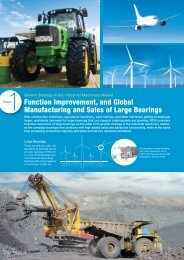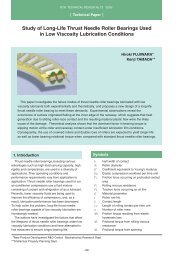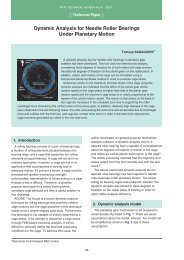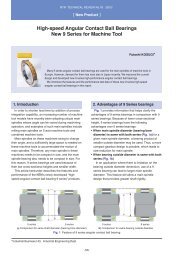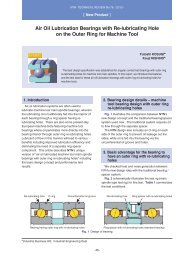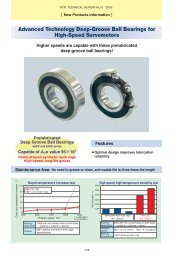Special Issue; Products for Industrial Machinery - NTN
Special Issue; Products for Industrial Machinery - NTN
Special Issue; Products for Industrial Machinery - NTN
You also want an ePaper? Increase the reach of your titles
YUMPU automatically turns print PDFs into web optimized ePapers that Google loves.
"Hybrid Bearphite" a Sintered Metal Sliding Bearing Inserted with Plastic<br />
Variation in bore diameter m<br />
50<br />
40<br />
30<br />
20<br />
10<br />
0<br />
Bearing bore diameter: 7.5 mm<br />
Resin linear expansion coefficient: 1410 -5 /˚C<br />
Ordinary<br />
resin bearing<br />
Hybrid Bearphite<br />
25 35 45 55 65<br />
Temperature ˚C<br />
Actual measurement<br />
with Hybrid Bearphite<br />
Fig. 12 Dimensional stability of HYBRID BEARPHITE<br />
dimensional variation is governed by the design of the<br />
resin layer thickness. In other words, if the thickness<br />
of a resin layer is determined through consideration of<br />
the dimensional variation of the shaft, and the<br />
clearance between the shaft and the bearing can be<br />
maintained at a constant dimension <strong>for</strong> a wider<br />
temperature range. This is a revolutionary new feature<br />
<strong>for</strong> resin bearings. Consequently, our Hybrid Bearphite<br />
can realize higher running accuracy at a wider<br />
temperature range, an achievement not previously<br />
attained with conventional resin bearing technologies.<br />
4.3 Bonding strength of the resin layer<br />
The resin layer must be firmly bonded to the<br />
sintered metal in order to maintain a high level of<br />
dimensional accuracy in a sintered metal sliding<br />
bearing. The results of a heat shock test are<br />
summarized in Table 3 to provide data about the<br />
bonding strength of the resin layer. In this test, the<br />
Hybrid Bearphite sliding bearing was subjected to 100<br />
heating-cooling cycles, with each cycle consisting of 1<br />
hour at -20˚C followed by 1 hour +60˚C. Through this,<br />
the dimensions be<strong>for</strong>e and after the heat shock test<br />
and the bonding strengths between the sintered<br />
metals and the resin layers were inspected.<br />
The dimensional variation occurring on our Hybrid<br />
Bearphite sliding bearing after undergoing the test<br />
Table. 3 Inner diameter change of HYBRID BEARPHITE<br />
after 100 cycles of heat shock test<br />
TP<br />
1<br />
2<br />
3<br />
Be<strong>for</strong>e test<br />
mm<br />
7.501<br />
7.510<br />
7.508<br />
After test<br />
mm<br />
7.500<br />
7.508<br />
7.504<br />
Variation<br />
m<br />
1<br />
2<br />
3<br />
State of<br />
bonding<br />
No peeling<br />
No peeling<br />
No peeling<br />
was very small. This means that the bonding is very<br />
firm between the sintered metal and the resin material<br />
of our Hybrid Bearphite.<br />
4.4 Chemical attack resistance<br />
Resin materials have been used increasingly on<br />
bearing housings in products such as office<br />
automation equipment. Because of the requirements<br />
<strong>for</strong> satisfying dimensional accuracy and impact<br />
strength, the resins often used on housings are<br />
amorphous resins that are not sufficiently oil-resistant.<br />
Examples of such resins include polycarbonate (PC)<br />
and acryronitrile-butadiene-stryrene copolymer (ABS).<br />
If an operating resin housing comes into contact with<br />
an inappropriate oil, it can develop cracks. This<br />
problem is known as solvent cracking, and it occurs<br />
when the compatibility of a resin with an oil is high.<br />
This allows the oil to penetrate and disentangle the<br />
polymer molecules that constitute the resin, causing<br />
the resin to develop cracks and/or crazing.<br />
Polycarbonate test pieces measuring 152 mm in<br />
length, 12.5 mm in width and 6.35 mm in thickness<br />
were prepared. Each oil was applied to the area of the<br />
test piece where the maximum tensile stress occurs,<br />
and a bending load was exerted <strong>for</strong> a specific duration<br />
(Fig. 13). Thus, the chemical attack quality of each oil<br />
was evaluated.<br />
The support distance adopted was 100 mm and the<br />
test temperature was 75˚C. As can be seen in Table<br />
4, silicone oil, which is included in the resin layer of<br />
PC<br />
Fig. 13 Test rig <strong>for</strong> chemical attack<br />
Table. 4 Chemical attack of oils <strong>for</strong> polycarbonate<br />
Condition Displacement<br />
(mm) 1.5<br />
Oil type Time (h) 3<br />
No oil<br />
Polyethylene glycol<br />
Polyol ester oil<br />
Ether oil (ADE oil)<br />
Mineral oil<br />
PAO <br />
Silicone oil <br />
Application of oil<br />
Support distance100<br />
<br />
<br />
3.0<br />
3<br />
<br />
3.5<br />
3<br />
<br />
<br />
<br />
Displacement<br />
3.5<br />
196<br />
<br />
polyolefin oil<br />
Oil blended in Hybrid Bearphite<br />
Symbols in the table: : no crack occurrence, : crack occurrence<br />
-113-




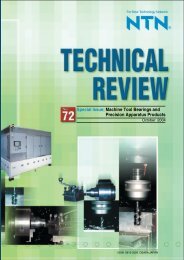
![[New Product] Unit Products for Office Equipment - NTN](https://img.yumpu.com/27154451/1/184x260/new-product-unit-products-for-office-equipment-ntn.jpg?quality=85)
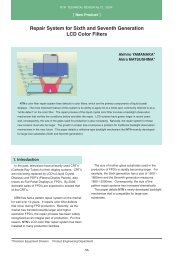
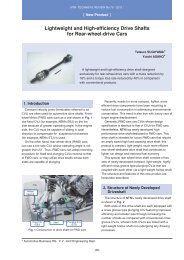
![[New Product] Development of Oil-impregnated Sintered ... - NTN](https://img.yumpu.com/27154427/1/184x260/new-product-development-of-oil-impregnated-sintered-ntn.jpg?quality=85)

